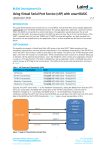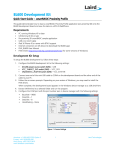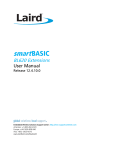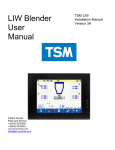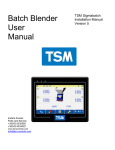Download bl600 setup - Alpha Micro Components
Transcript
BL600/BL620 MODULES OVER-THE-AIR APPLICATION DOWNLOAD Application Note v1.0 INTRODUCTION This document describes how to use Laird’s BL620 to download a smartBASIC application to a BL600 module over a BLE connection using the built-in virtual serial port service in the BL600. With the BL600 firmware, if its SIO7 input is tied to Vcc, then when a $autorun$ application is NOT running, it advertises for incoming connections for ten seconds after populating the local GATT server table with the serial port service as described in the BL600 user manual. REQUIREMENTS For this download, you need the following: A Windows PC UwTerminal Windows Utility available for free from Laird: https://laird-ews-support.desk.com/?b_id=1945 A DVK-BL600 development kit (DVK) and the module loaded with BL600 firmware v1.5.67.5 or newer A DVK-BL600 DVK/BL620-US dongle and the module loaded with BL620 firmware v12.2.5.5 or newer The smartBASIC application vsp.atcmd.sb. See https://github.com/Laird-Wooburn/BL620Applications/blob/master/vsp.atcmd.sb Note: You can obtain the necessary utilities, smartBASIC applications, firmware images, and app notes for firmware upgrading from Laird’s support website at https://laird-ews-support.desk.com/?b_id=1945 BL600 SETUP To set up the BL600, follow these steps: 1. 2. 3. 4. 5. 6. 7. Ensure one DVK is loaded with BL600 peripheral firmware v1.5.67.5 or newer. Plug the DVK into your PC. Locate the virtual serial comport numbers. Please note the comport number for later use. Open UwTerminal. In the Config window, ensure that the COM port for your BL600 is selected. Click OK to enter the Terminal tab. Submit the following command in UwTerminal and note the response (including 01). For example: 016FA1226A12EA. This is the MAC address of the BL600 and is used if you use the vsp.atcmd.sb application as described below : ATI 4 8. Ensure that SIO7 is tied to Vcc and CONN12 is as shown. This can be achieved using a jumper as shown in Figure 1. Americas: +1-800-492-2320 Option 2 Europe: +44-1628-858-940 Hong Kong: +852 2923 0610 www.lairdtech.com/bluetooth 1 Laird Technologies OTA Application Download Application Note Note: When SI07 is tied high on a BL600 and if the module does NOT contain the smartBASIC application $autorun$ then the module adds Laird’s virtual serial port service to the GATT table and advertises for ten seconds after power up or reset. Figure 1: SI07 tied to VCC and CONN12 using a jumper 9. Ensure that switch 2 (USB-DTR) on CON12 is on. 10. Ensure that the JLINK adapter used to download firmware to the module is no longer connected to the DVK. This is important because the reset buttons on the DVK do not function when the JLINK adapters are connected. BL620 SETUP To set up the BL620, follow these steps: 1. 2. 3. 4. 5. 6. 7. Ensure the BL620 DVK/BL620-US dongle is loaded with BL620 central firmware v12.2.5.5 or newer. Plug the DVK into your PC. Locate the virtual serial comport numbers. Please note the comport number for later use. Open UwTerminal. In the Config window, make sure the COM port for your BL620 is selected. Click OK to enter the Terminal tab. Download the vsp.atcmd.sb using the appropriate method for downloading smartBASIC applications. This process is documented in an application note available from Laird’s support website. OTA APPLICATION DOWNLOAD Note: This section assumes that the two DVKs are set up as described in the BL600 Setup and BL620 Setup sections. To download the OTA application, follow these steps: 1. Ensure you have the cross compiler file xcomp_BL600r2_hhhh_hhhh.exe in the same folder as the BL600 smartBASIC application that you want to download. Note: Step one is very important. Also confirm that the hhhh_hhhh in the cross compiler filename matches the information you get by sending AT I 13 to the BL600 module. 2. In the BL600 UwTerminal instance, ensure that the DTR checkbox is ticked. 3. If using a BL620-US dongle, skip to step 4. Otherwise on the BL620 devkit ensure that SIO7 is not tied to Vcc. 4. Run the vsp.atcmd application on the BL620 by typing vsp into the BL620 UwTerminal instance. 5. Press Enter. Embedded Wireless Solutions Support Center: http://ews-support.lairdtech.com www.lairdtech.com/wireless 2 Laird Technologies Americas: +1-800-492-2320 Europe: +44-1628-858-940 Hong Kong: +852-2268-6567 x026 OTA Application Download Application Note 6. With the vsp.atcmd application running, type the following into UwTerminal and press Enter to connect to your BL600:- atd <mac address> or connect <mac address> The <mac address> is obtained in step 4 of the BL600 Setup. 7. When CONNECT,OK displays, the application is in bridge mode. Data sent from UwTerminal is sent directly to the BL600 over the BLE connection via the VSP service. 8. To send your application OTA, right-click in UwTerminal (BL620) and select XCompile+Load as normal. >atd 01DF94CB7949AF CONNECT OK 9. When the app has finished downloading and +++ DONE +++ displays, you can switch from bridge mode back to command mode on the BL620. Note: Within the atcmd application. NOT in Interactive mode. To do this, ensure that LineMode is unticked and then send three caret characters (^^^). OK indicates that you can now send commands to the application. 10. To disconnect from the BL600, type ath or disconnect and press Enter in UwTerminal. 11. Exit the application by typing exit or quit. ^^^ OK >ath NO CARRIER >quit Version 1.0 00 LEVERAGING THE DEMO FOR YOUR USE CASE As has been demonstrated, the BL600 can be configured for accepting smartBASIC applications if SIO7 is tied to Vcc. There is currently no equivalent ‘no app’ solution for the BL620 side as it needs to know which device to connect to and therefore requires specific applications to be written. The sample application cmd.ble.manager.sb can be used as a basis for such a purpose. On the BL600, the virtual serial port functionality can be configured using the AT+CFG command or parameters such as baudrate, advertising timeout, and preferred connection intervals. See the AT+CFG section in the BL600 user manual for more information. A snapshot of that section is reproduced below for convenience but please be aware that this is a snapshot at the time of writing this application note and changes in the user manual are not reflected back to this document. If in doubt, please always refer to the user manual. Embedded Wireless Solutions Support Center: http://ews-support.lairdtech.com www.lairdtech.com/wireless 3 Laird Technologies Americas: +1-800-492-2320 Europe: +44-1628-858-940 Hong Kong: +852-2268-6567 x026 OTA Application Download Application Note AT+CFG COMMAND AT+CFG is used to set a non-volatile configuration key. Configuration keys are comparable to S registers in modems. Their values are kept over a power cycle but are deleted if the AT&F* command is used to clear the file system. The ‘num value’ syntax is used to set a new value and the ‘num ?’ syntax is used to query the current value. When the value is read the syntax of the response is 27 0xhhhhhhhh (dddd) …where 0xhhhhhhhh is an eight hex-digit number which is 0 padded at the left and dddd is the decimal signed value. AT+CFG num value or AT+CFG num ? If the config key is successfully updated or read, the response is \n00\r. Returns Arguments: Integer Constant num The ID of the required configuration key. All of the configuration keys are stored as an array of 16 bit words. Integer constant value This is the new value for the configuration key and the syntax allows decimal, octal, hexadecimal or binary values. This is an Interactive mode command and MUST be terminated by a carriage return for it to be processed. The following Configuration Key IDs are defined: Configuration Key IDs 40 41 42 43 44 45 100 Definition Maximum size of locals simple variables Maximum size of locals complex variables Maximum depth of nested user defined functions and subroutines The size of stack for storing user functions simple variables The size of stack for storing user functions complex variables The size of the message argument queue length Enable/Disable Virtual Serial Port Service when in interactive mode. Valid values are: 0x0000 Disable 0x0001 Enable 0x80nn Enable only if signal pin nn on module is HIGH 0xC0nn Enable only if signal pin nn on module is LOW 0x81nn Enable only if signal pin nn on module is HIGH and auto-bridged to UART when connected 0xC1nn Enable only if signal pin nn on module is LOW and auto-bridged to UART when connected Disable ELSE Embedded Wireless Solutions Support Center: http://ews-support.lairdtech.com www.lairdtech.com/wireless 4 Laird Technologies Americas: +1-800-492-2320 Europe: +44-1628-858-940 Hong Kong: +852-2268-6567 x026 OTA Application Download Application Note Configuration Key IDs 101 102 103 104 105 106 107 108 109 110 111 112 113 Definition Virtual Serial Port Service to use INDICATE or NOTIFY to send data to client. Prefer Notify 0 Prefer Indicate ELSE This is a preference and the actual value is forced by the TX characteristic property of the service. This is the advert interval in milliseconds when advertising for connections in interactive mode and AT Parse mode. Valid values: 20 to 10240 milliseconds This is the advert timeout in milliseconds when advertising for connections in interactive mode and AT Parse mode. Valid values: 1 to 16383 seconds In the Virtual Serial Port Service manager, data transfer is managed. When sending data using NOTIFIES, the underlying stack uses transmission buffers of which there are a finite number. This specifies the number of transmissions to leave unused when sending a lot of data. This allows other services to send notifies without having to wait for them. The total number of transmission buffers can be determined by calling SYSINFO(2014) or in interactive mode submitting the command ATi 2014 When in interactive mode and connected for virtual serial port services, this is the minimum connection interval in milliseconds to be negotiated with the master. Valid values: 0 to 4000 ms. If a value of less than 8 is specified, then the minimum value of 7.5 is selected. When in interactive mode and connected for virtual serial port services, this is the maximum connection interval in milliseconds to be negotiated with the master. Valid values: 0 to 4000 ms. If a value of less the minimum specified in 105, then it is forced to the value in 105 + 2 ms. When in interactive mode and connected for virtual serial port services, this is the connection supervision timeout in milliseconds to be negotiated with the master. Valid range: 0 to 32000 If the value is less than the value in 106, then a value double that specified in 106 is used. When in interactive mode and connected for virtual serial port services, this is the slave latency to be negotiated with the master. An adjusted value is used if this value times the value in 106 is greater than the supervision timeout in 107. When in interactive mode and connected for virtual serial port services, this is the Tx power used for adverts and connections. The main reason for setting a low value is to ensure that in production, if smart BASIC applications are downloaded over the air, then limited range allows many stations to be used to program devices. If Virtual Serial Port Service is enabled in interactive mode (see 100), then this specifies the size of the transmit ring buffer in the managed layer sitting above the service characteristic FIFO register. Value range: 32 to 256 If Virtual Serial Port Service is enabled in interactive mode (see 100), then this specifies the size of the receive ring buffer in the managed layer sitting above the service characteristic FIFO register. Value range: 32 to 256 If set to 1, the service UUID for the virtual serial port is as per Nordic’s implementation and any other value is a per the modified Laird’s service. See more details of the service definition here. The advert interval in milliseconds when advertising for connections in interactive mode and UART Bridge mode. Valid values: 20 to 10240 milliseconds Embedded Wireless Solutions Support Center: http://ews-support.lairdtech.com www.lairdtech.com/wireless 5 Laird Technologies Americas: +1-800-492-2320 Europe: +44-1628-858-940 Hong Kong: +852-2268-6567 x026 OTA Application Download Application Note Configuration Key IDs 114 115 116 Definition The advert timeout in milliseconds when advertising for connections in interactive mode and UART Bridge mode. Valid values: 0 to 16383 seconds (0 disables the timer and makes it continuous) Used to specify the UART baudrate when Virtual Serial Mode Service is active and UART bridge mode is enabled. Valid values: 1200, 2400, 4800, 9600, 14400, 19200, 28800, 38400, 57600, 76800, 115200, 230400, 250000, 460800, 921600, 1000000. If an invalid value is entered, then the default value of 9600 is used. In VSP/UART Bridge mode, this value specifies the latency in milliseconds for data arriving via the UART and transfer to VSP and then onward on-air. This mechanism ensures that the underlying bridging algorithm waits for up to this amount of time before deciding that no more data is going to arrive to fill a BLE packet and so flushes the data onwards. Given that the largest packet size takes 20 bytes, if more than 20 bytes arrive then the latency timer is overridden and the data is sent immediately. Embedded Wireless Solutions Support Center: http://ews-support.lairdtech.com www.lairdtech.com/wireless 6 Laird Technologies Americas: +1-800-492-2320 Europe: +44-1628-858-940 Hong Kong: +852-2268-6567 x026







